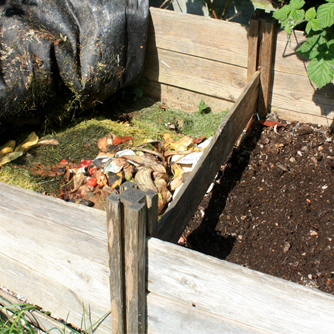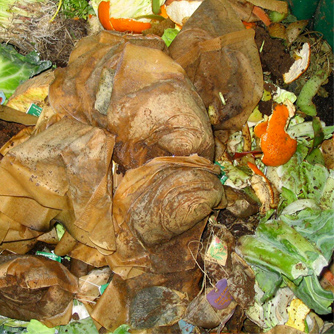How To Compost
BackComposting is an easy way to recycle organic materials (eg lawn clippings, prunings, leaves, weeds and kitchen scraps) using microbes to break them down into a rich earth-like substances we call compost.
The process uses microbes which need oxygen (aerobic) or microbes that happily survive without oxygen (anaerobic). Aerobic composting heats up and works faster than anaerobic methods. The heat can also kill weed seeds and diseases which may be present on the original clippings. The anaerobic technique is slower and doesn’t generate any heat.
Follow our checklist and you’ll be composting in no time!
Step 1: Compost heap or compost bin?
If you’ve got plenty of space and a large amount of green waste then a compost heap is the way to go. To kill weed seeds and pathogens the heap needs to be at least 1 square metre to generate sufficient heat.
Plastic compost bins are popular as they keep everything neatly contained and are perfect in smaller gardens. Be mindful that they won’t get hot enough to kill all seeds and pathogens so watch what you put into them.
Step 2: Ingredients
Pretty much anything organic can go in but large woody material will take longer to break down. Chop these up before putting them in to speed the process along. Kitchen scraps can go in but ensure your compost is securely sealed so it doesn’t attract rodents. Pet poo is not recommended as it can carry harmful diseases.

Compost bins are popular in small spaces
Step 3: Assembly
Aerobic Method
Add alternating layers 10-15cm thick of dry brown items (eg sticks, dead leaves) and moist green things (eg fresh clippings, weeds). Use a diverse mixture and add a bit more green materials than brown. Sprinkle some manure and a bit of lime or dolomite as you go. Fill the bin or heap in one go and water through with OCP eco-seaweed to kick start the process.
Anaerobic Method
Use a similar approach as above but the difference is you don’t need to fill it all in one go. Throw in what you have now and as you generate more waste keep adding to it bit by bit.
Step 4: Maintenance
Check moisture levels regularly. For both techniques the mixture should be moist but not wet or dry. If too wet add a bit of dry brown material or leave the lid off. If too dry flush through with some more eco-seaweed solution.
Aerobic systems should be turned at least weekly or they will become anaerobic and smelly. The more frequently you turn the ingredients the faster they break down. Corkscrew shaped devices for use in compost bins makes this very easy.
Anaerobic systems don’t need to be turned at all which is quite appealing to people short on time. Just keep in mind that it will take a lot longer for the compost to be ready.

Compost bays are great in big gardens where you have plenty of raw materials to compost
Step 5: The Finish Line!
The compost is ready when the mixture looks like rich earth and no pieces of the original materials are recognisable. Under ideal conditions an aerobic system can be ready in 2-3 weeks. Anaerobic systems will take at least several months.

Kitchen scraps are great compost ingredients


